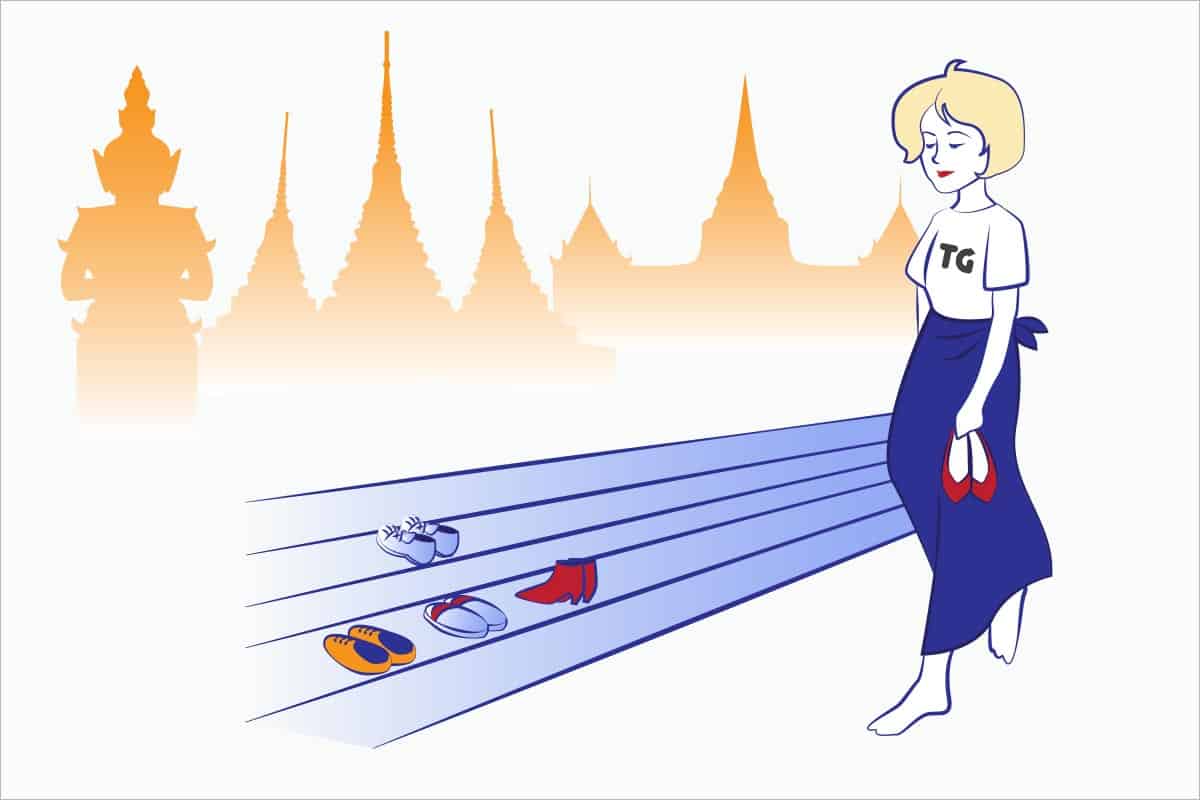Are you interested in learning about different cultures and thinking about embarking on a spiritual journey to pose profound questions about your life? Well, visiting Thailand is an excellent place to start. Thailand is packed full of the most unique spiritual places. They have been around for centuries and are significant to many people.
Thailand is considered to have plenty of highly spiritual and sacred places based on the traditions, cultures, and beliefs of the people for centuries, especially Buddhism, supernaturalism, and superstitions or spiritualism. These places also consist of various phenomena and important events involving Thai’s lifeways and mindsets, as well as thousands of years of history and significance attached to them.
When visiting these places, you will understand Thai culture and its people deeply through the perspective of tangible things, whether it is man-made places such as buildings or architecture, and natural sites with faith and myth stories created by local people.
Not only this, but you also might feel energy, connectedness, knowledge, inner peace, and tranquility since the presence of faith elevates these spiritual places, making them more than mere places.
Here are some important spiritual and sacred places in Thailand, categorized into two types: culture and nature. They are ready for you to discover.
5 Spiritual Places in Thailand Where You Can Connect with Culture
The numerous spiritual and peaceful places offering solitude to most travelers primarily relate to Buddhism. Buddhist temples and religious sites amount to approximately more than 40,000 in Thailand (1).
In Bangkok, the 3 most famous places where Thais always visit to worship and pay homage to the Buddha images enshrined inside the temples (during different important religious days) are Wat Phra Kaew, Wat Pho, Wat Arun. They are packed full of tourists on a daily basis.
1. Wat Phra Kaew, Bangkok
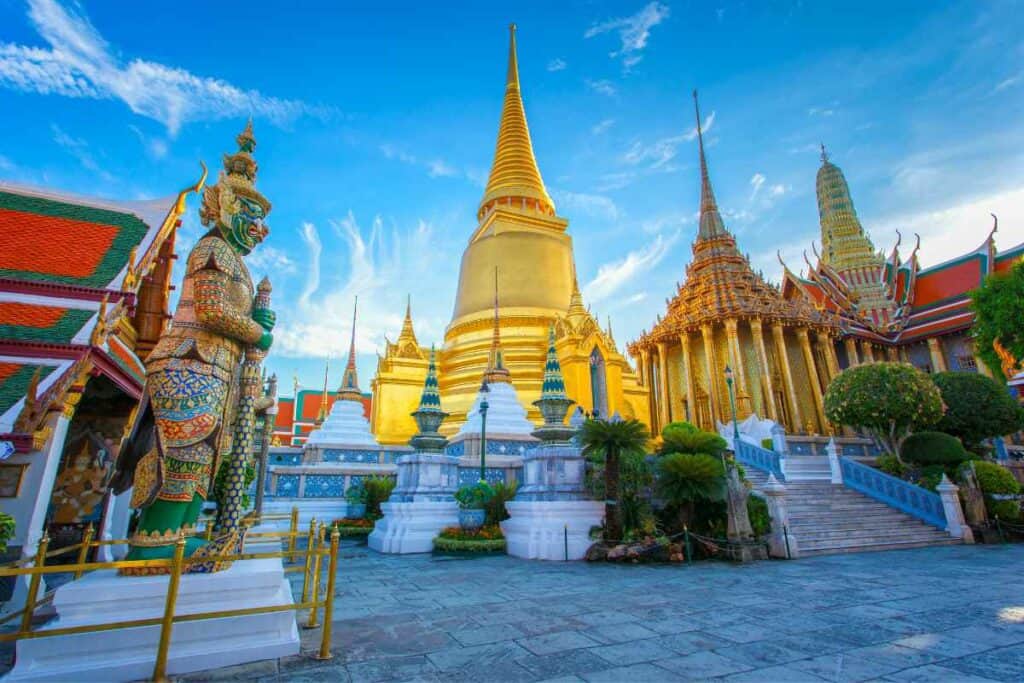
Wat Phra Kaew “วัดพระแก้ว,” officially called Wat Phra Si Rattana Satsadaram or commonly known as the Temple of the Emerald Buddha, is the most famous landmark in Bangkok. It was built in 1782 during the reign of King Rama I to enshrine the Emerald Buddha, which was made in the 15th century. It still holds tremendous significance for Thailand and the Thais.
This image is adorned with three different sets of gold seasonal costumes; a diamond-encrusted gold robe in the summer season, a gold-plated monk’s robe with headdress in the rainy season, and a solid gold robe in the winter season (2). The King of Thailand changed the clothes three times per year in a ceremony at the ceremonial costume change of the seasons around March, August, and November. There are also many other Buddha images inside the temple and beautiful mural painting on the walls surrounding the Ubosot that depicts the Ramakien, based on the Indian Ramayana epic.
This is the most important and sacred Buddhist temple in Thailand. It is still used for official events. Several royal ceremonies and state functions are held within the temple every year. The royal ceremony takes place to bring good fortune throughout the upcoming season, making people gather together on such a special day. It also is believed that those who come to worship the Emerald Buddha will receive a blessing for life, intelligence enhancement, and endless wealth and prosperity (4, 5, 6).
2. Wat Pho, Bangkok
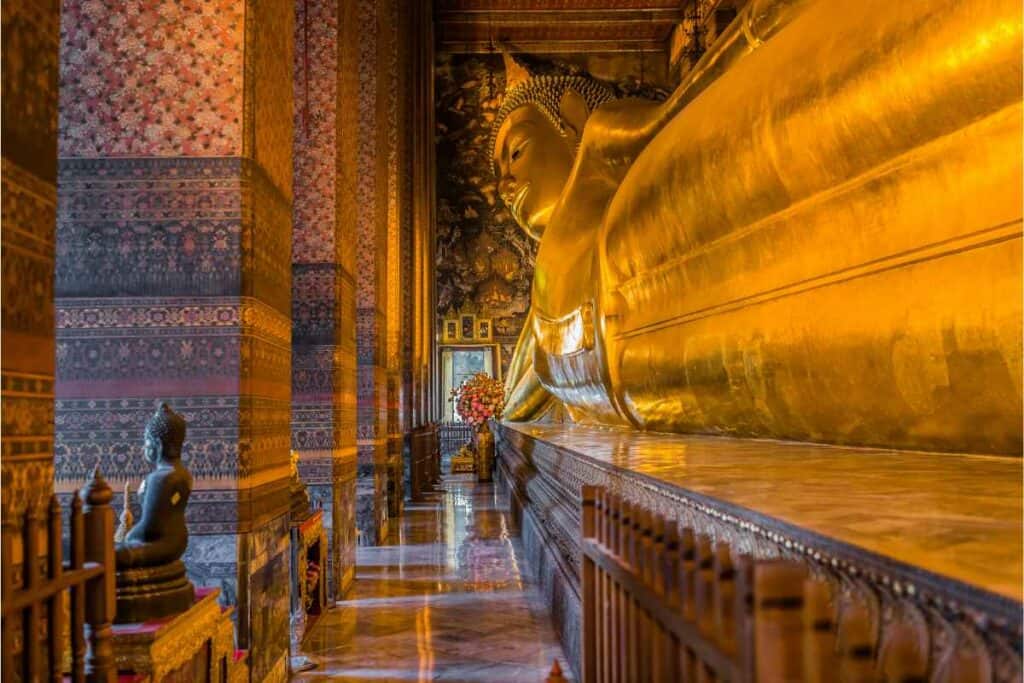
Wat Pho “วัดโพธิ์,” officially called Wat Phra Chetuphon, or commonly known as the Temple of the Reclining Buddha, is one of the most well-known landmarks for travelers. The construction of the temple was built in the Ayutthaya period. It was renovated in 1832 during the reign of King Rama III to be the center of education and art, making it Thailand’s first university (3).
It is on the list of six temples in Thailand classed as the highest grade of the first-class royal temples and has been registered by UNESCO’s Memory of the World (MOW) (7). Most importantly, it is the birthplace of the much valuable wisdom. This includes the historic inscriptions involving Buddhist precepts, literary works on traditional medicine and herbs, and mural painting on the walls showing traditional Yoga postures and traditional massage. It is now recognized as the famous learning center for meditation and traditional Thai massage, where people can learn techniques of various natural remedies for health.
Wat Pho holds the dual honors of having Thailand’s largest reclining Buddha image and the greatest number of Buddha images. These originated from the ruins of the former capitals Ayuthaya and Sukhothai in Thailand. The Wihan houses the highly impressive gold-plated Reclining Buddha, which is designed to illustrate the passing of the Buddha into nirvana, measuring 46 meters in length and 15 meters in height. The feet and the eyes are engraved with mother-of-pearl inlays of 108 auspicious signs of Buddha that combine India’s and China’s beliefs [6]. It also is believed that those who come to pay homage to the Reclining Buddha will receive fortune and abundance and live with happiness and peace.
3. Wat Arun, Bangkok
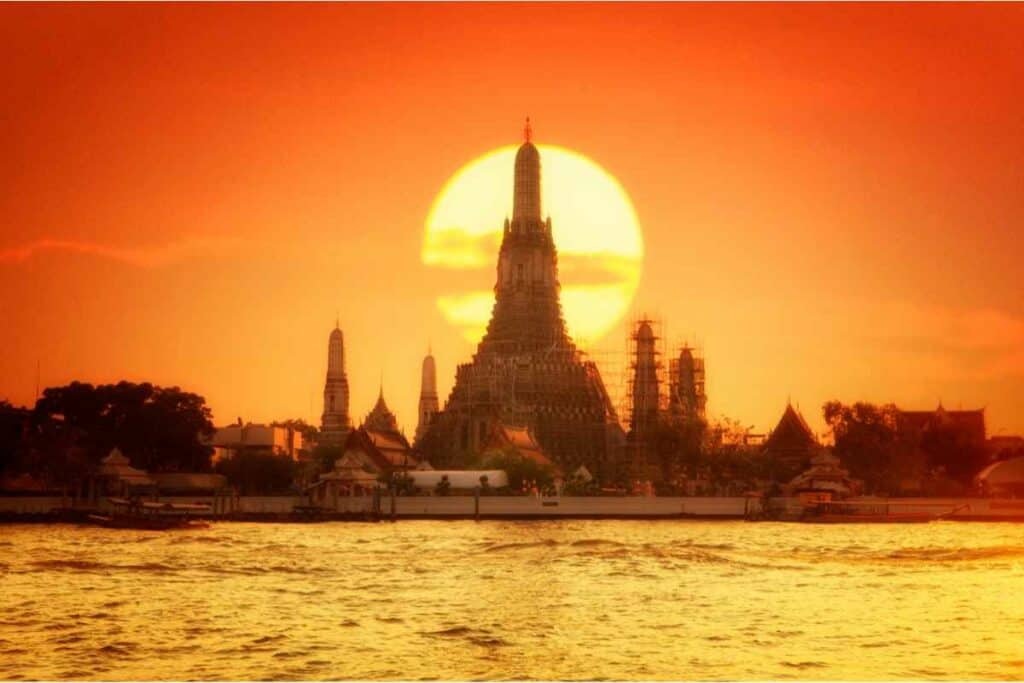
Wat Arun “วัดอรุณ,” officially called Wat Ratchawararam Ratchawaramahawihan, or commonly known as the Temple of the Dawn, is one of the most published images of Thailand. The temple was built in the Ayutthaya period known as ‘Wat Makok.’ It was first promoted as the royal temple by King Taksin in Thonburi Period under the name ‘Wat Chaeng’ before being renamed to ‘Wat Arun Ratchawararam’ during the Reign of King Rama IV (8, 9).
The temple consists of a magnificent elongated Khmer-style Phraprang (pagoda), 80-85 meters in height, decorated with colorful glazed Chinese porcelains, tiles, and seashells. It is surrounded by four smaller pagodas, Giant statues, the Ordination Hall, the Bell Tower, and many Buddha statues (10).
Most interestingly, Wat Arun’s pagodas were built and located to simulate the Buddhist Cosmology and Traiphum. The story of the three planes of existence describing the basic ethos of traditional Theravada religion (11). You will understand the Buddhist Cosmos through their architecture and buildings when visiting here.
Although the temple is one of the most popular tourism attractive places, it is also an important place of worship for Buddhists. It is believed that those who make merit at this temple and pay homage at the beginning of the year to the principal Buddha image will have a glorious life like the rising sun or the bright dawn. Each year, the ‘Royal Tod Kathin’ ceremony is still held at Wat Arun. By the end of the three-month lent period for Buddhist monks, the King of Thailand travels downriver in a Royal Barge Procession to present new robes to the monks to conserve religion and culture.
4. Wat Sri Chum, Sukhothai
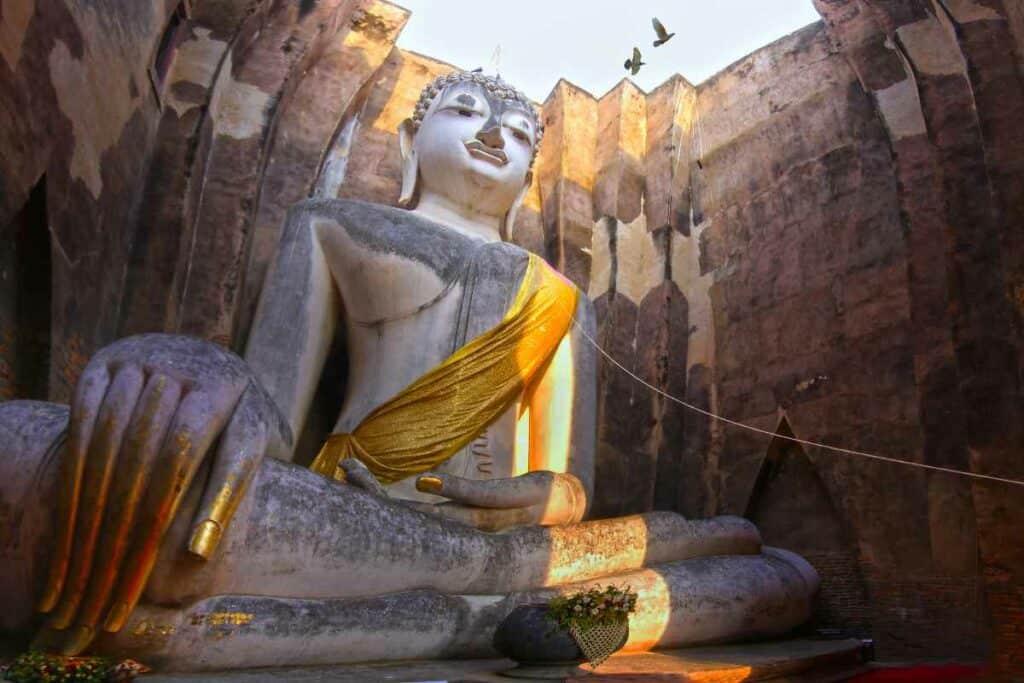
Wat Sri Chum or Wat Ruesi Chum is a part of the Sukhothai Historical Park, one of the most impressive World Heritage Site registered by UNESCO. Sukhothai was the capital of the first Kingdom of Siam during 13 – 14th century that consisted of numerous historical remains illustrating the beginnings of Thai architecture, known as the Sukhothai style, and Buddhism (12).
Wat Sri Chum was built in the late 14th century and houses a huge 11.3 meters width and 15 meters height seated Buddha statue wearing a serene facial expression called “Phra Achana.” This symbolizes a person who is unshaken, stable, or a person worthy of respect and worship. The wall of the passageway features 700-year-old paintings, while on the ceiling are more than 50 engraved slate slabs illustrating the life of Buddha (Jataka) scenes (13).
This large Buddha image is well-known as the legend of the speaking Buddha image “พระพุทธรูปพูดได้.” During the second half of the 16th century, there were many wars with the Burmese. The King wanted to boost the morale of his troops, so he ordered them to climb the narrow stairway that enshrined the Buddha image. Unnoticed by the other soldiers, he delivered a speech to his troops, making them believe that the voice was actually from the Buddha.
While another version of the legend says that the Burmese armies fled in fear upon approaching the Buddha image (14). Because of this, this temple is very famous for its sanctity, charm, and uniqueness, inviting tourists to visit and worship uninterruptedly.
5. Wat Mahathat, Ayutthaya
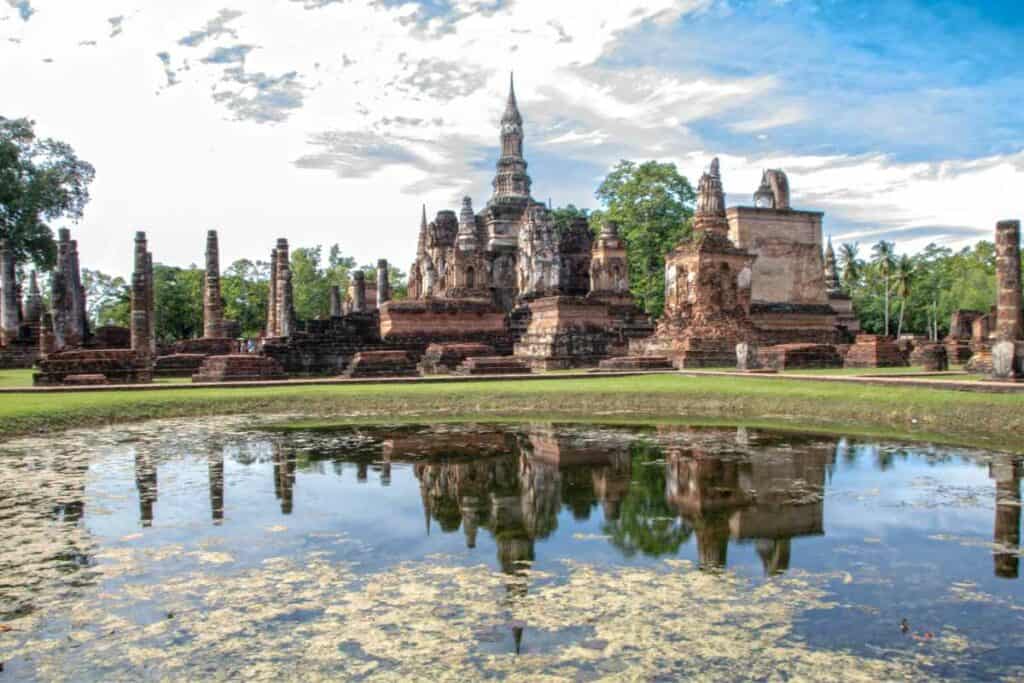
Wat Mahathat, commonly known as the Temple of the Great Relic, is also a UNESCO World Heritage Site. It was a royal Temple of the Ayutthaya period located in the center of old Ayutthaya, where the Kings had hosted many important royal ceremonies.
It is one of Ayutthaya’s most important temples that enshrined Buddha relics and was the seat of the Supreme Patriarch of Buddhism. Thus, the center of Buddhism in the Ayutthaya Kingdom (15, 16). When the Ayutthaya Kingdom failed in 1767, Wat Mahathat was severely damaged by fire and was since abandoned. Nowadays, the large monastery features pagodas, octagonal pagodas, a royal hall, small temples, murals under a Bodhi tree, and the famous sand-stone Ayutthaya-style head of the Buddha image in a tree’s root (17).
Most interestingly, the temple’s main pagoda (Phra Prang) represents Mount Meru – the center of the universe surrounded by the ocean, which was built to symbolize the Hindu and Buddhist views of the universe (18). While the style head of the Buddha image in a tree’s root is also known for miraculous beauty, becoming the world-famous photographed object known as UNSEEN Thailand.
5 Spiritual Places in Thailand Where You Can Connect with Nature
Buddhist temples and other spiritual sites can be popular destinations for connecting with nature, especially with the breathtaking landscapes shrouded in mystery and tranquility. Here are 5 spiritual places in Thailand where you can connect with nature or just admire the environment’s natural beauty.
1. Wat Tham Suea, Krabi
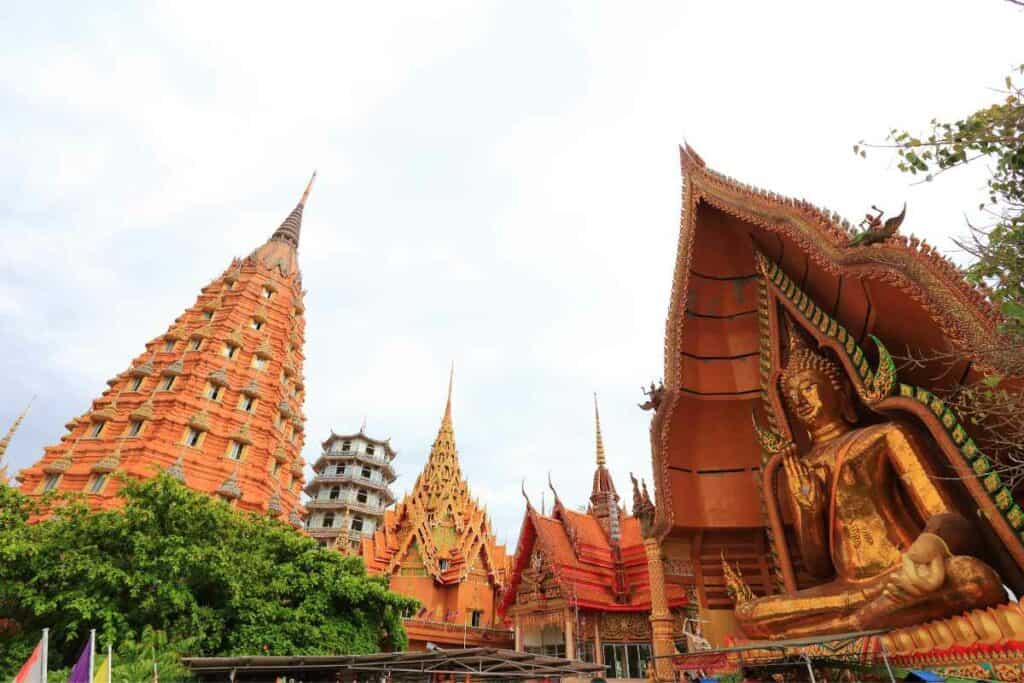
Wat Tham Suea or Tiger Cave is a Buddhist temple surrounded by stunning rainforests, large trees hundreds of years old, and the 360 panoramas encompassing the Andaman Sea. The most interesting things are the ‘footprint of the Buddha,’ which lies on the terrace, and ‘tiger footprints’ on the floor of the lower temple. The temple is also the meditation center of a Buddhism form called Vipassana that can help to focus on more spiritual matters (19, 20).
2. Wat Chaloem Phra Kiat Phrachomklao Rachanusorn, Lampang
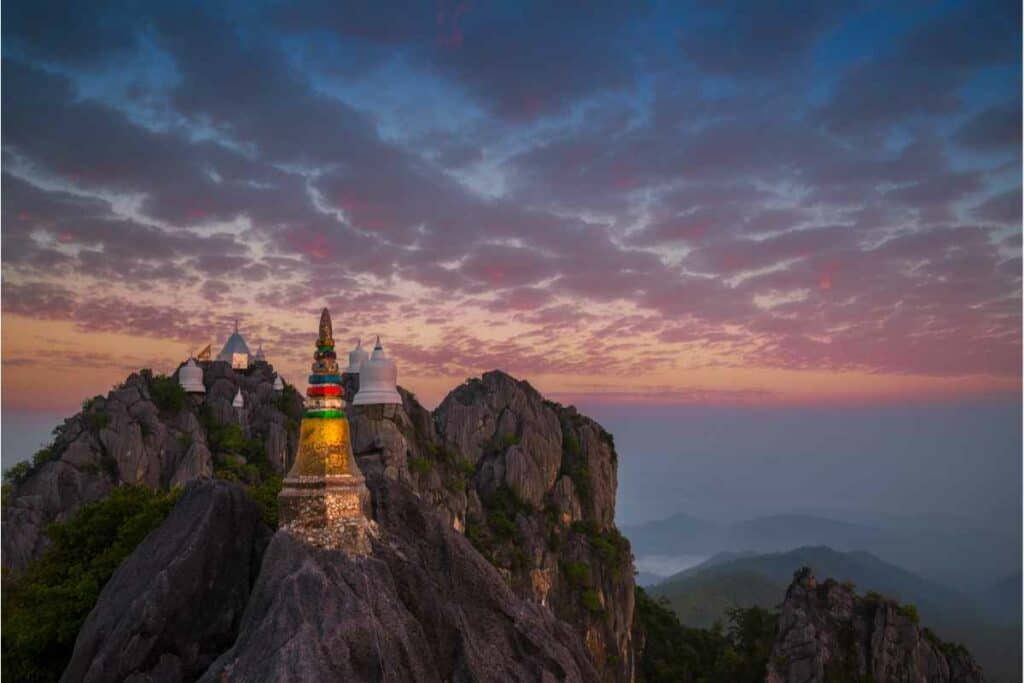
Wat Chaloem Phra Kiat Phrachomklao Rachanusorn is one of the newest attractions from the ‘Unseen Thailand’ campaign, which is becoming the most famed destination. It was built over ten years ago by a revered monk from Lampang and 46 dedicated workers. They spent two years carrying materials and equipment to build these temples in rugged terrain.
The temple is a spectacle unlike anywhere else in Thailand, with golden and white pagodas spread throughout the sharp peaks and upon precipices. One of the exciting parts is that the visitors will pass by a footprint that is believed to be the footprint of Buddha. They will be surrounded by stunning 360 panoramas of nature and the shimmering stupas in bright sunlight (22, 24).
3. Wat Pa Phu Kon, Udon Thani
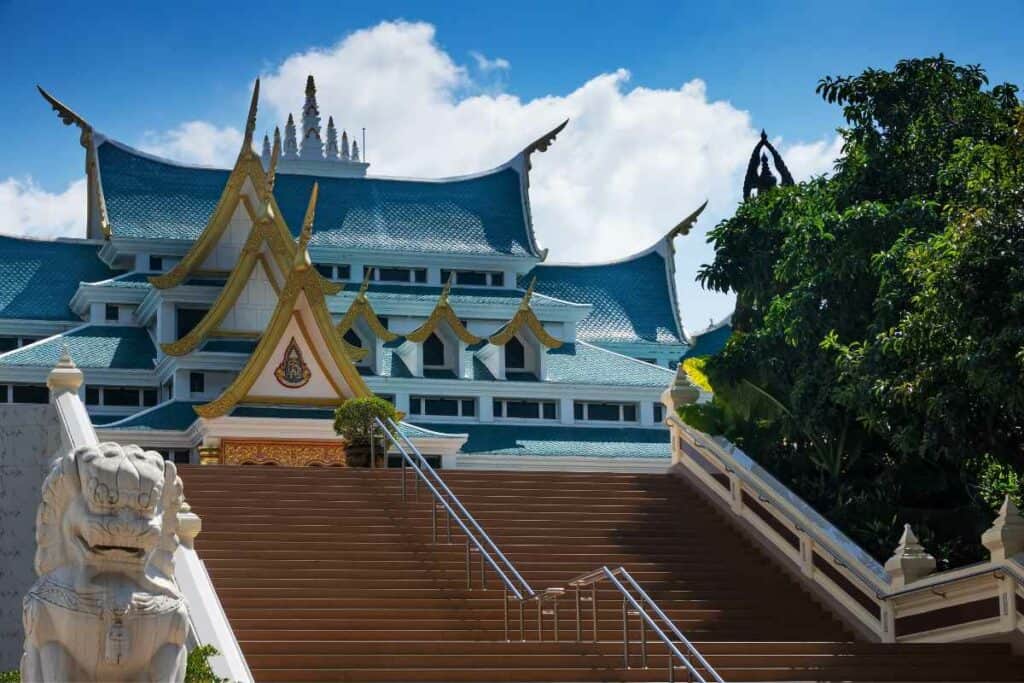
Wat Pa Phu Kon was built between 2010-2013, with the funds used for construction from a Thai donor in honor of King Rama IX. It follows the footsteps of the late King in keeping forests fertile. It is an outstanding forest temple that is unlike most religious buildings.
Although this temple lacks history itself, the architecture is beautiful in appearance and set in idyllic surroundings with sculptures and artworks that represent some mystical, philosophical, or other meaning related to Buddhism. The temple also serves as a place of pilgrimage for practitioners of the Buddhist faith (21, 22).
4. Wat Phra That Doi Suthep Ratchaworawihan, Chiang Mai
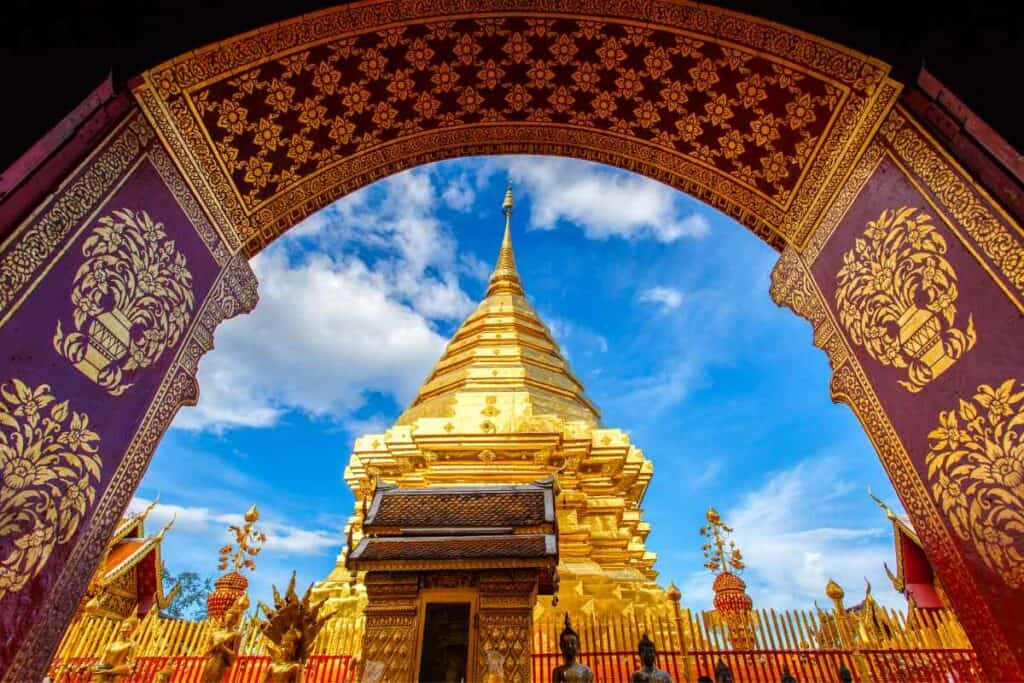
Wat Phra That Doi Suthep Ratchaworawihan is one of northern Thailand’s most sacred temples and was built in 1383 to enshrine a piece of bone said to be from the shoulder of the historical Buddha. A legend states that the King entrusted a white elephant with a magical relic necessary for the temple to be built. And people followed the elephant up to the Doi Suthep Mountain, and the exact place where the elephant died marked the spot where the temple had to be built.
Visitors need to climb the staircase flanked by naga to reach the temple. The climb is intended to help devotees accrue Buddhist merit. It also has the Vipassana Meditation Center within the temple that conducts various religious outreach programs for visitors (22, 23).
5. Thamma Park (Ban Khao Na Nai), Surat Thani
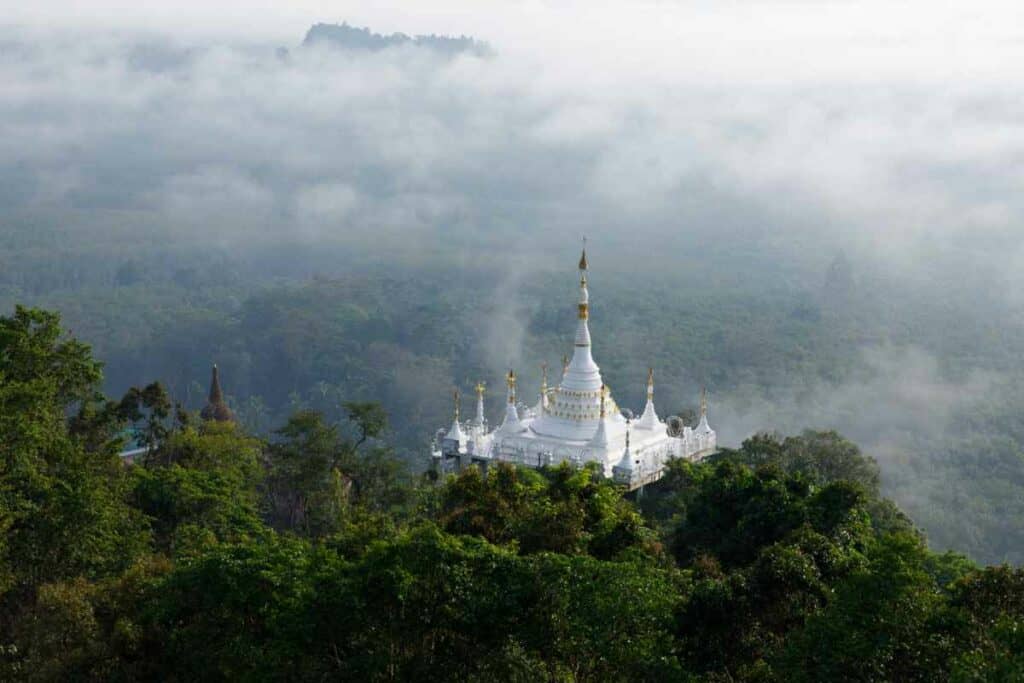
Thamma Park (Ban Khai Na Nai) is a popular Buddhist temple with astonishing architecture – the 9 top arch gates called Bhuddhawadi and the sky pagoda containing Buddha’s relics. It is located on a limestone hilltop, almost 300 meters. The main highlight is the temple’s arch gate, where sunlight shines on the gates in the early morning, making a stunning, mysterious scenery between nature and man-made structures (22).
5 Etiquettes to Remember While Visiting the Spiritual Places in Thailand
These spiritual places are places of worship and holy ground for people. Thus, it is essential to remember that you are expected to act with due respect when visiting, such as:
- Take off your shoes and hats before entering the buildings.
- Avoid improper or unacceptable clothes and ensure that your clothes cover your shoulders and your knees.
- Ask permission before taking pictures, and do not take too many photos even if you are allowed (only applies to active places of devotion and worship).
- Do not touch or climb on top of the Buddha statues. Buddha statues are religious objects, and you are expected to treat them with the utmost respect, and not lean on, sit on, touch, or point their feet towards them.
- Do not touch Buddhist monks, especially if you are female. Women are not allowed to touch monks, as well as to hand items to monks.
Conclusion
As you can see, with numerous spiritual places based on Buddhism, Thailand is a dream destination for travelers seeking a spiritual journey. Thailand is a country where you can intensively study the nature of reality, grow your understanding of people’s beliefs, and rejuvenate your mindset.
You are truly spoilt for choice. This article has covered some great places to start and use as inspiration for your own odyssey.
Like always, if you want to discover more about Thailand, stay guided with ThaiGuider. You might learn something you never knew about this unique country.
References
1. Buddhism), สำนักงานพระพุทธศาสนาแห่งชาติ (National Office of. จำนวนวัดในประเทศ ปี 2555-ปัจจุบัน. สำนักงานพระพุทธศาสนาแห่งชาติ (National Office of Buddhism). [Online] August 03, 2021. https://www.onab.go.th/th/content/category/detail/id/805/iid/9905/.
2. GRAND PALACE & EMERALD BUDDHA. THE EMERALD BUDDHA SEASONAL COSTUME CHANGING. GRAND PALACE & EMERALD BUDDHA. [Online] [Cited: January 25, 2022.] https://www.emerald-buddha.com/costume-change-emerald-buddha/.
3. Thailand, Amazing. 9 Sacred Sites In Bangkok. Amazing Thailand. [Online] July 2017. https://www.amazingthailandebook.com/files/book_182/4c5704efd21aeded3771e643e832cbfa1559117901509.pdf/.
4. Faiththaistory. พระแก้วมรกต ความศักดิ์สิทธิ์ที่หลวงปู่มั่นได้บอกไว้. Faiththaistory. [Online] July 10, 2017. https://www.faiththaistory.com/emerald-buddha/.
5. User : GLS***83. 6 เรื่องน่ารู้ก่อนเที่ยววัดพระแก้วกรุงเทพฯ 2020. Trip.com. [Online] Ocotober 27, 2020. https://th.trip.com/blog/things-to-know-wat-phra-kaew-2020/.
6. Bangkok Biz News. 9 “วัด” 10 พระพุทธรูปสำคัญแห่งเกาะรัตนโกสินทร์ ทำบุญไหว้พระรับ “ปีใหม่”. Bangkok Biz News. [Online] January 1, 2022. https://www.bangkokbiznews.com/lifestyle/980364/.
7. Sullivan, Boris. UNESCO Registers Wat Pho As A “Memory of the World”. Thailand Business News. [Online] December 27, 2011. https://www.thailand-business-news.com/tourism/34124-unesco-registers-wat-pho-as-a-memory-of-the-world.html/.
8. หอสมุดแห่งชาติ กาญจนาภิเษก สงขลา. ประวัติวัดอรุณราชวราราม. หอสมุดแห่งชาติ กาญจนาภิเษก สงขลา. [Online] [Cited: January 25, 2022.] https://www.finearts.go.th/songkhlalibraryk/view/15356-ประวัติวัดอรุณราชวราราม/.
9. กองโบราณคดี (Office Of Archaeology). วัดอรุณราชวราราม ราชวรมหาวิหาร ปีงบประมาณ ๒๕๕๖ . กองโบราณคดี (Office Of Archaeology). [Online] [Cited: January 25, 2022.] https://www.finearts.go.th/archae/view/9365-วัดอรุณราชวราราม-ราชวรมหาวิหาร-ปีงบประมาณ-๒๕๕๖/.
10. Thailand, Amazing. Wat Arun (Temple Of Dawn). Tourism Authority Of Thailand. [Online] [Cited: January 25, 2022.] https://www.tourismthailand.org/Attraction/wat-arun-temple-of-dawn/.
11. นายรอบรู้ นักเดินทาง (Nairobroo). วัดอรุณฯ คุณเคยรู้สิ่งเหล่านี้หรือไม่. นายรอบรู้ นักเดินทาง (Nairobroo). [Online] [Cited: January 25, 2022.] https://www.nairobroo.com/travel/tips-travelers/wat-arun/.
12. UNESCO. Historic Town Of Sukhothai And Associated Historic Towns. UNESCO. [Online] [Cited: January 25, 2022.] https://whc.unesco.org/en/list/574/.
13. Sukhothai. อุทยานประวัติศาสตร์สุโขทัย. Sukhothai. [Online] [Cited: January 25, 2022.] http://www.sukhothai.go.th/tour/tour_01.htm/.
14. Museum Thailand. พระพุทธรูปพูดได้. Museum Thailand. [Online] [Cited: January 25, 2022.] https://www.museumthailand.com/th/2075/storytelling/พระพุทธรูปพูดได้/.
15. Renown Travel. Wat Mahathat “The temple of the Great Relic”. Renown Travel. [Online] [Cited: January 26, 2022.] https://www.renown-travel.com/historicalsites/ayutthaya/wat-mahathat.html/.
16. History Of Ayutthaya. WAT MAHA THAT (วัดมหาธาตุ). History Of Ayutthaya. [Online] January 2015. [Cited: January 25, 2022.] https://www.ayutthaya-history.com/Temples_Ruins_MahaThat.html/.
17. Amazing Thailand. Wat Phra Mahathat. Tourism Authority of Thailand. [Online] [Cited: January 25, 2022.] https://www.tourismthailand.org/Attraction/wat-phra-mahathat/.
18. หรีด ณ วัด. สืบประวัติวัดมหาธาตุ แห่งอยุธยา วัดที่ต้องไปสักครั้งในชีวิต. หรีด ณ วัด. [Online] February 3, 2021. https://www.wreathnawat.com/วัดมหาธาตุ-อยุธยา/.
19. Krabi Tourism. Wat Tham Sua ( Tiger Cave Temple). Krabi-Thailand. [Online] [Cited: January 25, 2022.] http://www.krabi-tourism.com/krabi/watthumsua.htm/.
20. Hotels.com. Krabi Tiger Cave. Hotels.com. [Online] [Cited: January 25, 2022.] http://www.krabi-hotels.com/seedo/tiger-cave.htm/.
21. Jonesy In Thailand. Wat Pa Phu Kon Temple. Jonesy In Thailand. [Online] [Cited: January 25, 2022.] https://jonesyinthailand.com/nong-khai/attractions/wat-pa-phu-kon-temple/.
22. ทรัสต์. รวม 10 วัดบนเขาเมืองไทย สวยจับใจ ต้องไปให้ได้สักครั้ง. tripgether. [Online] January 6, 2021. https://www.tripgether.com/อัปเดตเรื่องเที่ยว/รวม-10-วัดบนเขาเมืองไทย-ต้องไปให้ได้สักครั้ง/.
23. Lonely Planet. Wat Phra That Doi Suthep. Lonely Planet. [Online] [Cited: January 25, 2022.] https://www.lonelyplanet.com/thailand/chiang-mai-province/chiang-mai/attractions/wat-phra-that-doi-suthep/a/poi-sig/1243262/357655/.
24. HongKhao Village. Wat Chaloem Phra Kiat Phrachomklao Rachanusorn. HongKhao Village. [Online] [Cited: January 25, 2022.] https://www.hongkhaovillage.com/Attractions/wat-chaloem-phra-kiat-phrachomklao-rachanusorn.html/.
THINKING ABOUT A TRIP TO THAILAND?
I am working on a FREE Thailand Travel Guide with a FULL 7 Day Itinerary. Be the first to receive it!
Thank you for signing up.
Something went wrong.
